Once you’ve launched your Android app, the job isn’t over, it’s just the beginning.
Regular Android app maintenance is what keeps your app running smoothly, securely, and user-friendly in the long run.
Whether you’re a startup, a growing business, or just someone who built an app with a great idea, knowing how to maintain an Android app can save you from crashes, bugs, and poor user reviews.
In this blog, we’ll walk you through a complete Android app maintenance guide, covering everything from the right process to maintain an Android app to what it actually costs.
Let’s dive in and help you keep your app updated, secure, and performing at its best.
What Is Android App Maintenance?
Android app maintenance is the ongoing process of updating, optimizing, and enhancing your app after its initial launch.
It's not just about fixing bugs; it's about ensuring your app remains compatible with the latest Android OS versions, integrates seamlessly with third-party services, and continues to meet user expectations. Regular mobile app maintenance helps in improving performance, enhancing security, and providing a better user experience.
Neglecting maintenance can lead to user dissatisfaction and app uninstalls. According to a 2023 survey, 62% of users will remove an app after a negative experience. Furthermore, 50% of apps are uninstalled within 30 days due to poor performance.
From a financial perspective, the cost to maintain an Android app typically ranges between 15% to 20% of the original development cost annually. This investment is crucial for keeping your app functional, secure, and competitive in the ever-evolving app market.
In summary, Android app maintenance is essential for the longevity and success of your app. Regular updates and optimizations not only enhance user satisfaction but also protect your app from becoming outdated.
Why Android App Maintenance Matters?
Developing mobile apps is just the beginning. What truly determines its long-term success is how well you maintain it.
Android app maintenance is a continuous process that ensures your app remains functional, secure, and valuable for users. Without regular maintenance, even the best apps can lose relevance, become buggy, or worse, crash altogether.
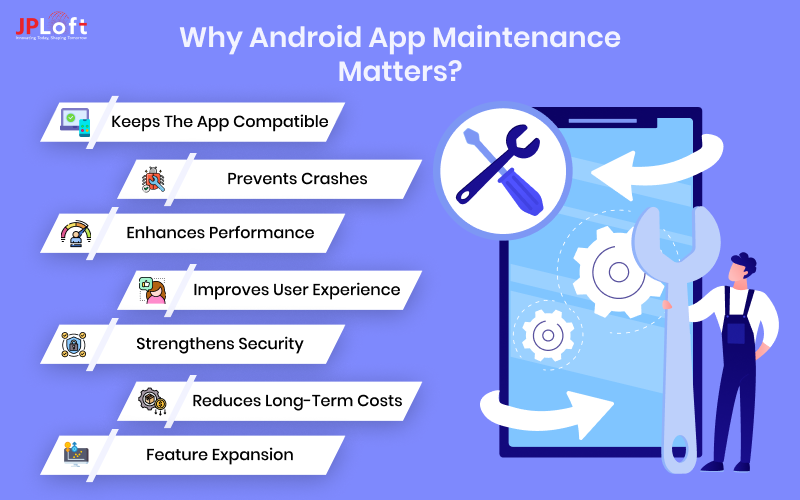
1. Keeps the App Compatible with the Latest Android Versions
Android releases frequent OS updates, and if your app doesn’t adapt, users may face performance issues or even app crashes.
One of the key steps in the Android app maintenance process is ensuring ongoing compatibility. A well-maintained app works seamlessly on new devices and OS versions, offering a consistent experience to all users.
2. Fixes Bugs and Prevents Crashes
Even after testing, bugs can sneak into production.
Regular maintenance allows you to fix issues quickly based on user feedback or performance tracking. Timely bug fixing is a core part of every Android app maintenance guide, helping you build credibility and retain your audience.
3. Enhances App Performance
Over time, apps can slow down due to outdated code, bloated databases, or third-party library conflicts.
Scheduled maintenance helps optimize performance, making the app faster, lighter, and more responsive. If you are wondering why maintain an Android app, this is a big reason: users are quick to abandon slow apps.
4. Improves User Experience
User expectations evolve rapidly.
With routine updates, you can introduce modern UI/UX trends, improve navigation, and make the app more intuitive. Happy users are loyal users. Maintenance ensures your app evolves with their needs, making your app relevant and engaging.
5. Strengthens Security
Security vulnerabilities can ruin your app’s reputation.
Regular patches, library updates, and compliance checks help protect user data. A trusted guide to maintain an Android app always emphasizes cybersecurity. With increasing data protection laws, it’s more important than ever to stay ahead on this front.
6. Reduces Long-Term Costs
While some hesitate due to the cost to maintain an Android app, skipping maintenance leads to much bigger expenses later, like complete reworks or emergency bug fixes. Think of maintenance as insurance: it prevents critical failures and keeps the app healthy at a lower cost over time.
7. Supports Scaling and Feature Expansion
Planning to add new features? You’ll need a strong, well-maintained foundation. Regular maintenance makes your codebase clean, scalable, and ready to support new functionalities. It ensures your team spends less time fixing the past and more time building the future.
In short, Android app maintenance is not a luxury, it’s a necessity. From reducing bugs to improving user retention and boosting long-term ROI, regular maintenance keeps your app alive and competitive.
If you have just launched or your app has been live for years, following the right Android app maintenance strategy will ensure it continues to deliver value, performance, and satisfaction to your users.
Steps To Follow for Android App Maintenance
If you are serious about the long-term success of your mobile application, connecting with the leading Android App Development Company can help you design and develop your dream app.
Maintaining an Android app involves continuous efforts to keep it updated, functional, and in tune with user expectations.
If you are a startup or an enterprise, understanding how to maintain an Android app properly will help reduce churn and improve user satisfaction.
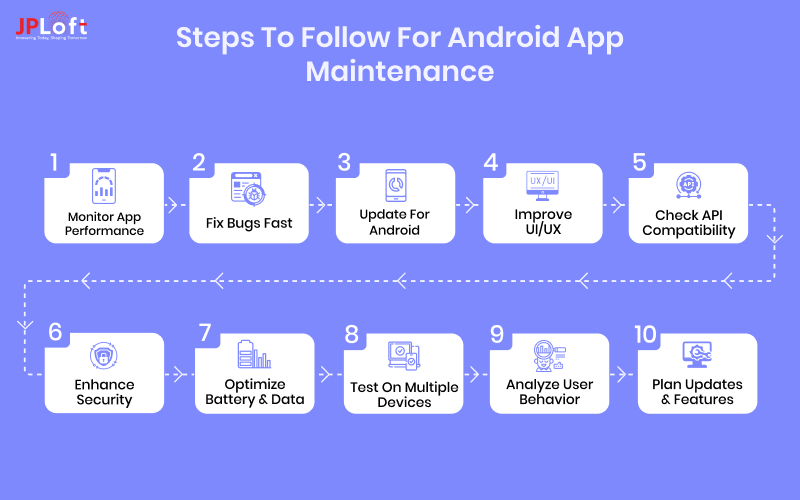
Step 1: Regularly Monitor App Performance
One of the most important aspects of Android app maintenance is monitoring the app’s performance on a regular basis.
You can use tools like Firebase Performance Monitoring or Google Analytics to track load times, crashes, screen rendering speed, and user behavior.
Consistent monitoring helps catch performance issues early and ensures your Android app performs seamlessly across different devices and networks. If ignored, even minor glitches can affect your Play Store rating and cause users to uninstall your app.
Step 2: Fix Bugs Promptly
Even after extensive testing, bugs are inevitable once your app hits the real world.
One crucial part of the app maintenance process is addressing those bugs as soon as they appear. Use crash reporting tools and monitor user feedback to identify bugs and prioritize fixes.
A quick response not only improves the user experience but also shows your users that you care, ultimately boosting your app’s credibility.
Step 3: Update for Android OS Changes
Google rolls out Android OS updates frequently, and your app must adapt to these changes. This is where ongoing Android app maintenance becomes essential.
An outdated app may not function properly or might even be removed from the Play Store. To avoid issues, it’s crucial to keep your codebase updated and aligned with the latest Android versions.
Regular updates not only improve performance and security but also ensure you can submit your app without rejections due to outdated standards or incompatibility.
Step 4: Improve UI/UX Based on Feedback
User feedback provides direct insight into what's working and what’s not.
During the process, actively collect and analyze user feedback through in-app surveys, reviews, or support tickets.
Improving UI/UX, based on real user input, helps you design better navigation flows, reduce friction points, and increase overall satisfaction. A fresh, user-friendly design is often what makes users come back.
Step 5: Check for Third-Party API Compatibility
If your app uses third-party APIs for services like payments, maps, or social login, part of your Android app maintenance must include regular compatibility checks.
API providers often update their versions, change endpoints, or deprecated features. If you don't keep up, parts of your app might stop working, impacting both user experience and app functionality.
Step 6: Enhance App Security
Security isn’t a one-time setup, it requires continuous updates.
Android app maintenance should involve regular security audits, updating encryption protocols, and fixing vulnerabilities. This is especially important if your app handles sensitive user data like personal details, payment info, or location data.
Failure to maintain high security standards can lead to data breaches and legal liabilities.
Step 7: Optimize for Battery & Data Usage
Users are quick to delete apps that drain battery or eat up mobile data.
As part of your Android app maintenance strategy, evaluate and minimize background processes, compress images, and reduce the frequency of server requests. Efficient resource usage not only improves the app’s reputation but also boosts user retention.
Step 8: Test Across Multiple Devices
The Android ecosystem is vast, with thousands of devices varying in screen size, resolution, processing power, and OS version.
Android app maintenance means regularly testing your app on popular and new devices to ensure consistent performance. This minimizes the chances of compatibility issues and ensures a smooth user experience for all users.
Step 9: Track and Analyze User Behavior
Understanding how users interact with your app is vital to maintaining its relevance. Use analytics tools to study usage patterns, feature adoption, and drop-off points.
These insights allow you to prioritize updates and feature enhancements more effectively. It’s a smart way to guide your Android app maintenance efforts based on actual user data.
Step 10: Plan Regular Updates and Feature Enhancements
Keeping your app fresh with new features, seasonal updates, or UI tweaks shows users that you’re actively investing in the product.
The right process to maintain an Android app always includes planning and releasing updates based on user feedback, performance data, and technological trends. This not only retains current users but can also attract new ones.
In short, following a structured Android app maintenance guide ensures your app stays functional, competitive, and user-friendly.
If you're thinking about the cost to maintain an Android app, remember, proactive maintenance saves far more in the long run than emergency fixes ever will.
Tools to Help You Maintain an Android App
Maintaining an Android app goes far beyond fixing bugs, it's about ensuring consistent performance, security, compatibility, and user satisfaction. Luckily, there are several tools that make Android app maintenance more efficient and organized.
If you're wondering how to maintain an Android app effectively, these tools are essential to your workflow.
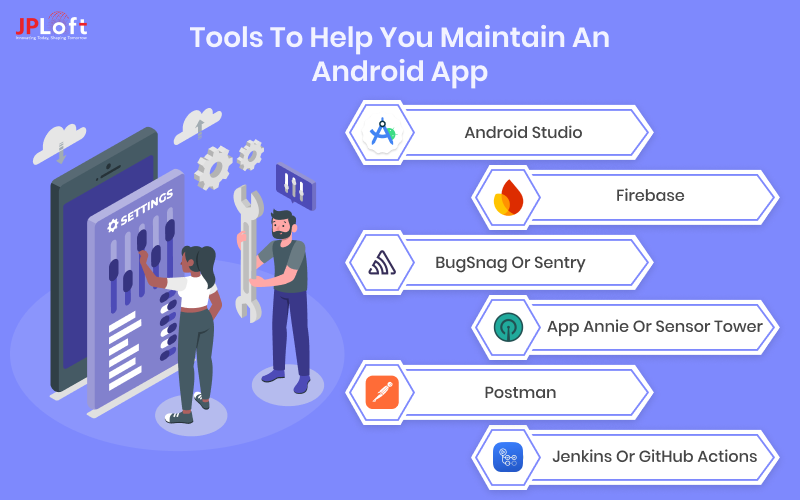
1. Android Studio
As the official IDE for Android development, Android Studio isn’t just for coding, it also plays a vital role in Android app maintenance.
With features like the Layout Inspector, Profiler, and Emulator, you can easily detect performance issues, memory leaks, and UI glitches. It's an indispensable tool in any maintenance process.
2. Firebase
Firebase by Google offers an all-in-one suite of tools for monitoring app performance and maintaining Android apps.
Crashlytics helps identify crashes in real time, while Performance Monitoring reveals where your app is lagging.
With Firebase Analytics, you can understand user behavior and make informed decisions. It’s especially useful in reducing long-term Android app maintenance cost by proactively spotting issues before users report them.
3. BugSnag or Sentry
These tools are designed for error monitoring and reporting.
They give you detailed reports on bugs, the devices affected, and the frequency of issues. BugSnag and Sentry integrate seamlessly with your app to support a smooth process by minimizing downtime and improving user experience.
4. App Annie or Sensor Tower
For app performance tracking and competitor analysis, these tools are extremely useful.
While they don’t directly fix bugs, they help you keep your app aligned with user expectations and market trends. This is part of a smart strategy, maintaining relevance as well as functionality.
5. Postman
API issues can disrupt your Android app.
Postman lets you test and debug APIs efficiently, ensuring your app stays connected to third-party services without glitches. It’s a critical part of maintaining Android apps that rely heavily on backend integrations.
6. Jenkins or GitHub Actions
Automate your testing and deployment using CI/CD tools like Jenkins or GitHub Actions. These reduce manual errors and speed up the process of releasing bug fixes or updates, essential to keeping Android app maintenance smooth and consistent.
Choosing the right tools is key to keeping your Android app stable, scalable, and secure. With the right Android app maintenance tools in place, you’ll reduce mobile app maintenance costs, improve performance, and build stronger relationships with your users.
How Often Should You Update Your Android App?
One of the most common questions businesses and developers ask is: How often should I update my Android app?
While there’s no universal rule, regular updates are a crucial part of Android app maintenance. In general, most successful apps push updates every 2–4 weeks, depending on user feedback, new features, or bug fixes.
The key reason why maintaining an Android app regularly is important is that the mobile ecosystem evolves rapidly.
Android frequently releases OS updates, new devices hit the market, and user expectations shift. To stay competitive, your app must keep up with these changes. A well-planned Android app maintenance process ensures your app remains functional, relevant, and secure.
Here are some smart tips from our Android app maintenance guide:
-
- Fix Bugs Immediately: Even a small crash can result in negative reviews. Update your app quickly when bugs are reported.
- Monitor OS Updates: With each Android OS release, test your app and push updates to ensure compatibility.
- Add New Features Periodically: Don’t wait too long to introduce value-added features based on market trends or user suggestions.
- Security Updates: Keep your app secure with regular patches, especially if you handle user data or payments.
- Performance Improvements: Regularly update your app to reduce load times, improve battery usage, or enhance UX.
If you are wondering how to maintain an Android app without overloading your team or budget, consider a predictable schedule, such as monthly minor updates and quarterly major releases.
As for the Android app maintenance cost, frequent but lighter updates tend to be more affordable than sporadic large ones.
Following the right process to maintain an Android app not only saves money but also builds user trust and loyalty.
How Much Does Android App Maintenance Cost?
Once your app goes live, the journey isn’t over. In fact, that’s when the real work begins. One of the biggest factors you need to plan for is the cost to maintain an Android app.
While many assume the major investment is in development, long-term success depends just as much on smart, consistent upkeep.
So, what’s the cost to maintain an Android app? On average, businesses should budget 15% to 20% of the initial mobile app development cost annually for app maintenance.
For example, if you spent $50,000 building your app, expect to spend around $7,500 to $10,000 per year maintaining it.
This Android app maintenance cost includes several ongoing activities like:
-
- Bug fixing and crash resolution
- OS compatibility updates
- Server and third-party API management
- Adding new features or UI improvements
- Performance optimization and testing
- Security patches and compliance updates
Understanding the right process to maintain an Android app also helps in managing costs. For instance, regular performance checks, proactive bug fixing, and timely updates prevent expensive breakdowns in the future.
If you're looking for a guide to maintain an Android app, consider breaking down the maintenance into phases: routine checkups, seasonal updates (based on Android OS upgrades), and user-driven improvements.
This strategy not only improves the app experience but also keeps the budget in check.
When figuring out how to maintain an Android app without overspending, it’s smart to work with an experienced on-demand app development company.
They can help you build a clear roadmap that aligns your goals with your budget, keeping your app stable, secure, and user-friendly.
Best Practices for Android App Maintenance
Building an app is just the beginning. Keeping it running smoothly, updated, and secure is what really matters.
If you’re wondering how to maintain an Android app the right way, following best practices is the key. Android app maintenance isn’t a one-time task, it’s an ongoing process that ensures your app stays relevant, bug-free, and loved by users.
Let’s look at the best practices to follow, if you are handling it in-house or partnering with the best mobile app development company.
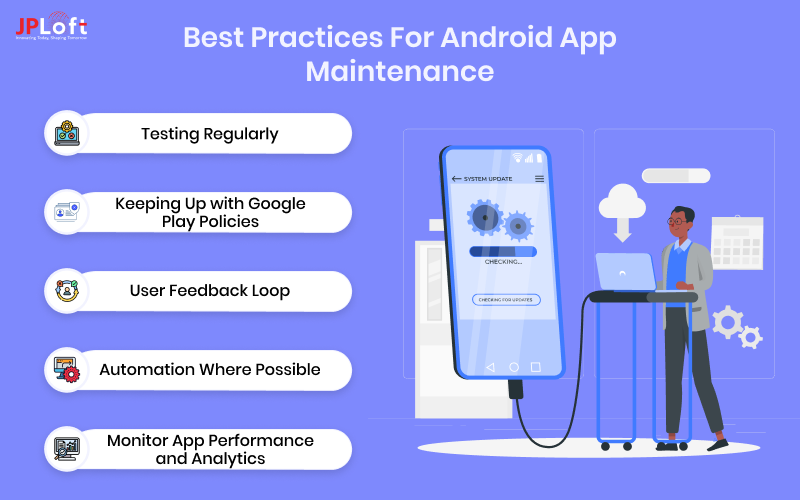
1. Testing Regularly
One of the most critical parts of Android app maintenance is regular testing.
As Android OS updates roll out or new features are added, it’s essential to test your app across different devices and versions of Android.
This helps catch any bugs or performance issues early. Regular testing can also help ensure that the app remains compatible with the latest Android updates, reducing the risk of crashes or functionality loss.
2. Keeping Up with Google Play Policies
Google Play regularly updates its guidelines and policies for apps.
To ensure that your app remains live on the platform, it's crucial to stay informed about these changes. Adhering to Google’s policies is part of the Android app maintenance process to avoid any compliance issues, such as app removal from the store or the need for significant updates.
Keeping your app in line with new privacy, data handling, and security regulations is essential for maintaining its credibility and long-term success.
3. User Feedback Loop
Your users are the best source of information for improving your app.
Implementing a user feedback loop allows you to listen to their needs, identify bugs, and understand what features they want in future updates.
Regularly collecting and analyzing user reviews or using in-app feedback tools can provide insights into pain points, helping you prioritize updates that improve user satisfaction.
Continuously evolving your app based on user feedback is key to maintaining an app that meets user expectations.
4. Automation Where Possible
Automation can streamline many aspects of Android app maintenance.
Using tools to automate testing, bug reporting, and even performance monitoring can save you time and effort. Automated systems allow you to track the app’s health in real-time and get alerts when something goes wrong.
Automation also helps with deploying updates or pushing out critical bug fixes, ensuring that your app stays up-to-date without manual intervention. Embracing automation is an efficient way to manage your app’s ongoing health and performance.
5. Monitor App Performance and Analytics
Keeping a close eye on your app’s performance is essential to maintain high user satisfaction. Use analytics tools to track metrics like load time, crashes, battery usage, and retention rates. This proactive monitoring helps you detect issues before they affect many users. Including performance tracking in your guide to maintain an Android app ensures data-backed decisions and smarter updates. Over time, this reduces the cost to maintain an Android app by avoiding expensive fixes down the line.
Looking for a Reliable Partner for Android App Maintenance?
Keeping your app up and running smoothly takes more than just occasional updates; well, you require a committed, experienced mobile app maintenance service that understands every step of the Android app maintenance process.
At JPLoft, we offer end-to-end maintenance and support services tailored to your app's unique needs.
Whether you're looking to reduce the cost to maintain an Android app, fix bugs, stay updated with Google Play policies, or implement a proactive maintenance strategy, we've got your back.
Our experts follow the right process to maintain an Android app, from regular performance checks to seamless feature updates. Don't let small issues turn into big problems. Let us help you keep your app fresh, fast, and future-ready!
Conclusion
Maintaining an Android app is not a one-time task, it’s an ongoing process that keeps your app relevant, secure, and user-friendly.
From fixing bugs to improving performance and aligning with the latest Google Play policies, every step in the Android app maintenance process ensures your users stay engaged and your app stays competitive.
If you are a startup or an established business, following the right process to maintain an Android app can save costs, improve user satisfaction, and boost long-term ROI.
If you ve been wondering how to maintain an Android app the smart way, now you have the answers. And if you need expert help, don’t hesitate to reach out to a trusted team for complete Android app maintenance support.
FAQs
Android app maintenance is the ongoing process of updating, optimizing, fixing bugs, and enhancing the performance of an app after it has been launched. It ensures the app remains secure, compatible with the latest OS updates, and continues to meet user expectations. Regular maintenance improves user retention and keeps your app competitive.
Ideally, you should update your Android app at least once every 2–3 months. However, security patches, bug fixes, or major Android OS changes may require more frequent updates. Regular updates are a core part of effective Android app maintenance.
Key steps include bug fixing, performance optimization, security updates, adapting to OS changes, integrating user feedback, and ensuring compliance with Google Play policies. These elements form the foundation of a strong Android app maintenance process.
Yes, automation tools can help with testing, crash reporting, analytics tracking, and CI/CD deployment. Using automation wherever possible reduces manual work and speeds up the Android app maintenance cycle.
Absolutely. A continuous user feedback loop helps you understand what’s working, what’s not, and where improvements are needed. It plays a key role in keeping your app user-centric and updated.





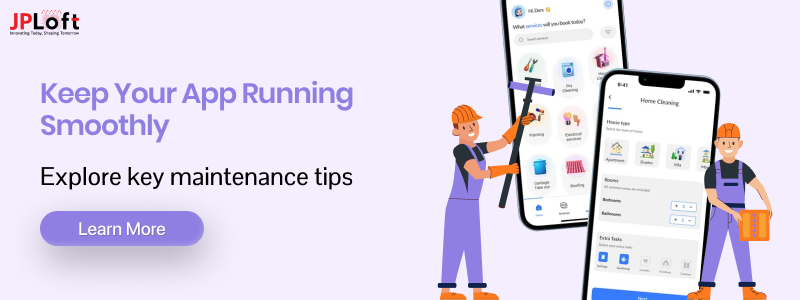

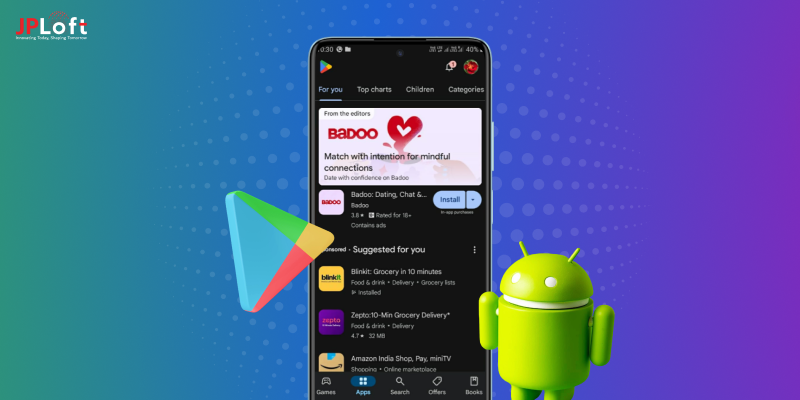
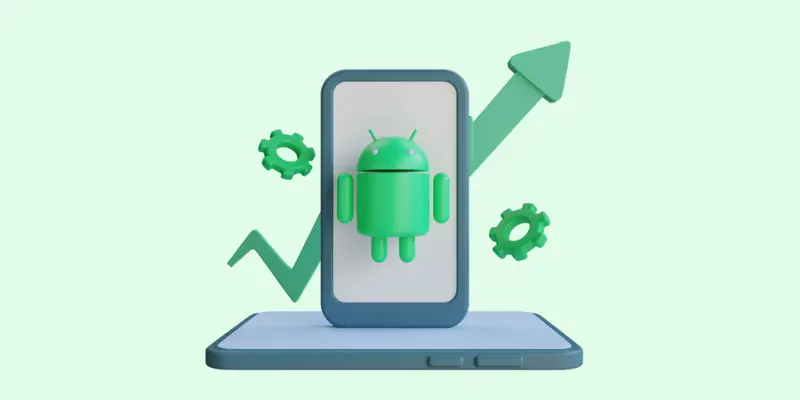



Share this blog